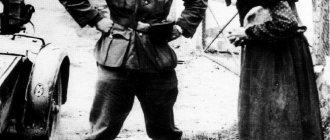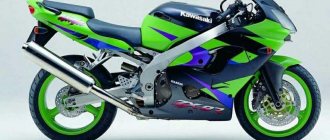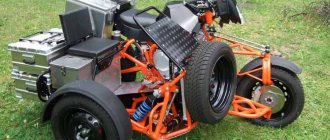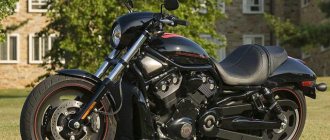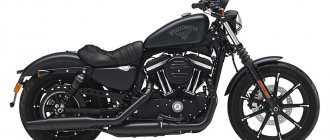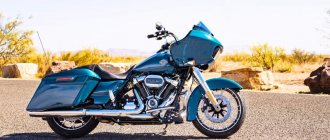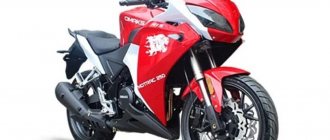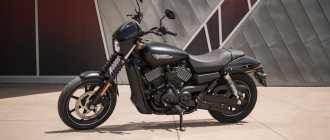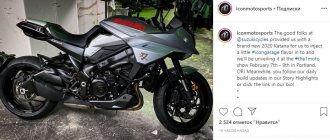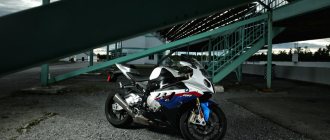Model class : cruiser.
Years of production/sales: 1997-2004
The BMW R1200C was first introduced in 1997 and was produced until 2004. This model is a class of cruisers built on the basis of the current models of the 1100 and 1150 series. The BMW R1200C was the company's attempt to enter the classic cruiser market and compete with American and Japanese motorcycles. However, the model turned out to be extremely specific and unlike similar motorcycles with a classic layout, and the price was clearly higher than its competitors. This led to the project being stopped in 2004. But representatives of the BMW concern promised that they would later return to creating a more advanced cruiser with a more promising engine and layout. A total of 40,218 units were produced. BMW R1200C in various modifications, including the younger version - BMW R850C.
Main modifications of the BMW R1200C:
- BMW R1200C (Classic) is the standard version of the motorcycle. Features spoked wheels.
- BMW R1200C Avantgarde – available since 2000. It features a low steering wheel, less chrome and the presence of ABS (optional).
- BMW R1200C Independent (aka Phoenix on the American market) - available since 2001. It features one seat, cast aluminum wheels, two-tone paint, fog lights, and a small windshield.
- BMW R1200C Montauk – available in 2004. Differs in alloy wheels, small windshield, instrument panel from the R1200CL and additional headlight at the bottom.
- BMW R1200CL – available since 2002. It is a touring version of the motorcycle. Features a massive front fairing (HD Electra Glide style), built-in saddlebags, a passenger backrest, cruise control, larger wheels, a 6-speed gearbox, a heel-toe shift paddle, a 12V socket, heated grips and seats, and a generator 840W.
- BMW R1200CLC - the version is similar to the previous one, but with ABS, radio, CD radio and plenty of chrome.
- BMW R1200C Troika - version similar to Montauk, but with a side trailer (sidecar).
The main feature of the BMW R1200C is the traditional 2-cylinder boxer engine with a capacity of 1170 cc. see, producing 61 hp. power and 98 Nm of torque. The characteristics of the engine differ significantly from the engines of the more popular flagship models of the BMW 1100 and 1150 series - to obtain “chopper” thrust, the engine was significantly derated, which noticeably reduced the maximum power, but made the torque fully available already at 3000 rpm.
Otherwise, the BMW R1200C model has a traditional BMW layout - a composite frame with a load-bearing element in the form of an engine, a cardan drive, a proprietary Telelever suspension at the front (not Paralever at the rear, but a pendulum with a monoshock absorber - BMW Monolever).
Specifications
Technical characteristics of BMW R1200C:
| Model | BMW R1200C |
| Motorcycle type | cruiser |
| Year of issue | 1997-2004 |
| Frame | composite, engine - load-bearing element |
| engine's type | 2-cylinder 4-stroke boxer (Boxer) |
| Working volume | 1170 cc |
| Bore x Stroke | 101x73 mm |
| Compression ratio | 10.0:1 |
| Cooling | air-oil |
| Number of valves | 4 valves per cylinder, 1 camshaft per cylinder head |
| Fuel supply system | Bosch Motronic MA 2.4 injector |
| Ignition type | electronic |
| Maximum power | 61 hp at 5000 rpm |
| Maximum torque | 98 Nm at 3000 rpm |
| Transmission | 5-speed (R1200CL - 6-speed) |
| type of drive | cardan |
| Front tire size | 100/90-ZR 18 spoked/cast (Independent) (150/80-VR16 - R1200CL, Montauk - cast) |
| Rear tire size | 170/80-ZR 15 spoked/cast (Independent) (170/80-VR 15 - R1200CL, Montauk - cast) |
| Front brakes | 2 discs, 305 mm, 4-piston calipers (optional ABS) |
| Rear brakes | 1 disc, 285 mm, 2-piston caliper (optional ABS) |
| Front suspension | BMW Telelever, stroke - 144 mm |
| Rear suspension | pendulum with BMW Monolever monoshock absorber (preload adjustment), stroke - 100 mm |
| Overall dimensions (LxWxH) | 2340x1050x1130 mm (2415x1075x1435 mm - R1200CL, 2370x1120x1340 mm - Montauk) |
| Seat height | 740 mm (745 mm - R1200CL, 770 mm - Montauk) |
| Gas tank capacity | 17.0 l (including 4 l reserve) |
| Maximum speed | 168 km/h |
| Acceleration to 100 km/h (0-100) | 5.8 sec |
| Motorcycle weight (curb) | 256 kg (308 kg - R1200CL, 265 kg - Montauk) |
With the R1200C Montauk, BMW got to the core of the American riding style. We'll have to find out whether Germany's high technology and digital know-how are the right vehicle for this by comparing it to the American original, the Harley-Davidson "Fat Boy."
BMW had a pretty tough time deciding on the cruiser design. On the one hand, it was necessary to pay attention to the technical part in order to produce an ultra-modern motorcycle - and this is visible at first glance. On the other hand, the elaborate shapes and generous use of chrome parts were meant to evoke nostalgia for the romance of the highway.
However, buyers did not even pay attention to such efforts. The blue and white cruiser sold like hot cakes - this can most likely be explained by the trend that exists on the market - modern, reliable and environmentally friendly equipment in an interesting design.
Such extremes were alien to the motorcycle from Milwaukee. Nobody racked their brains over the design of the “Fat Boy”—one look at pictures from the 60s was enough for inspiration. Many things cannot be improved. As a last resort, they can be improved.
As for the technical part, Harley-Davidson engineers had to solve their favorite problem - convincing the company's board and sales department of the need for reform. Clearly, this should have nothing to do with the sacred principle of the V-Twin with a 45-degree cylinder camber.
It is almost impossible to please every customer. But it was clear what everyone expected. It was supposed to be, in essence, not a new motorcycle, but a popular, good old model, simply improved. And without any newfangled nonsense, of course.
ENGINES
Harley-Davidson, like BMW, has an air-cooled two-cylinder engine. This is where the similarities end; all other engine parts are absolutely different.
BMW placed an eight-valve “Boxer” with a longitudinal horizontal crankshaft, Harley-Davidson relied on a V-Twin with two valves per cylinder and a crankshaft rotating transversely to the direction of travel. And while the American comes with long tappets, the Bavarian model combines the cam with short tappets. This is important because it justifies the significantly higher speed of BMW engines.
On the test bench, both cruisers showed rather poor performance. BMW produced 2 kilowatts more, Harley fought back with a 3-point advantage in torque. The Montauk also showed slight superiority when reaching top speed.
An interesting difference was found in traction and acceleration. Here the excess weight of the Fat Boy stood in his way - he had to move almost 50 kilograms more than the BMW, which was immediately reflected in the instrument readings.
However, both models don’t even force you to think about driving at the limit - you don’t want to squeeze full gas at all. It's all about mechanical charm, a good shake, character and personality. The BMW ran a whole circle purring, directing its vibrations directly at the driver. The engine feels good and feels very nice. It is quite typical for the Boxer to sway from the torque of the longitudinal crankshaft. Old BMW fans dealt with this feature perfectly with the help of an appropriate guiding movement, moreover, completely automated by the subconscious. Some even stubbornly claim that there was no push from the torque.
Harley's Twin, on the contrary, is located across the direction of travel, which eliminated the problem from the very beginning. The vibration of a large engine is softened through rubber gaskets. Overall, the Harley-Twin roars richly. Even when this engine is roaring at full power, it expresses itself softer and more delicately than the somewhat rough BMW Boxer.
For rear-wheel drive, both manufacturers have chosen easy-to-maintain solutions. BMW again offered a driveshaft in a powerful swingarm, while Harley-Davidson retained the belt drive.
BMW wins the engine competition, although it is a moot point regarding classic claims. But along with better driving characteristics, it boasts high-quality engine electronics and, very importantly, a variable catalyst.
All these circumstances, along with a significant weight advantage, are not very favorable for the walking "Fat Boy".
DRIVE
The Fat Boy can be ridden relaxed, with your body straight and your elbows slightly bent behind the wide steering column. The lowest seating position allows the 1.60-tall driver to confidently touch the ground with both feet.
The speedometer turned out to be less practical, but very suitable in style to the fuel tank. Controlling turn signals with automatic return to the reverse position and two buttons on the right and left is a virtue that is hard to beat. But BMW pulled off this trick with ease. Electricians from Munich have turned a three-way switch into something that Japanese competitors couldn't do in 10 years with a single button.
An example of absolute thoughtlessness from our point of view is the serial “Fat Boy” alarm system. 10 seconds after turning on the ignition, the electronic “guard dog” begins its work, whether you need it or not. During normal refueling - they removed the cap, inserted the hose, refueled, took out the hose, closed the lid, paid, left - the alarm has to be turned off up to 5 times. Or you have to refuel with the ignition and headlights on. At a gas station, this is prohibited by the fire department and drains the battery unnecessarily, but it saves your nerves. So the owner also has a choice - how to maintain calm and order.
What sets the Montauk apart from other R 1200C models is the thick front wheel with a correspondingly widened telescopic fork.
The expected negative characteristics, such as insufficient precision in steering and operation of the brakes in an inclined position, turned out to be fair, but in fact less pronounced than it seemed at first glance to our expert who tested the motorcycle. Moreover, “Montauk” for a cruiser has good stability and enormous freedom to tilt.
The Harley-Davidson chassis turned out to be much softer and more comfortable; this motorcycle could easily get by with a small share of the BMW's depreciation reserve. In addition, its steel frame is not too rigid.
Thanks to its thin tires and relatively comfortable geometry, the Fat Boy handles turns with ease, despite its dry weight of 325 kilograms.
The Fat Boy braking system features two disc brakes, one at the front and one at the rear. Despite the four-piston system, braking to a complete stop is only possible if you use extreme force.
BMW braking is on a completely different level, at least when the motorcycle is equipped with an ABS system, which costs an additional thousand Euros on top of the price. In this case, you can brake with minimal effort. Nevertheless, you can cope with the indecently “trumpeting” electric motor and hydraulic pump by increasing the pressure in just three brackets. The driver only needs to lightly press the lever - the effect of the braking system can be so strong. The combination of all the brakes acts extremely harshly. The Munich craftsmen did well to offer this self-assisting brake mechanism only in conjunction with ABS. In this case, you can brake harder without the risk of ending up on the ground.
Harley-Davidson's temperament turned out to be extremely calm and harmonious. The quiet engine and easy handling make for a relaxing ride without being bothered by weak brakes. This gait is, of course, also characteristic of Montauk. But he can run differently. Guided by an experienced hand on the highway, it can show sporty class.
As for passenger convenience, Harley has a clear advantage here. BMW can only win the tie with extra comfortable passenger airbags for a couple of hundred Euros on top of the price.
CONCLUSION
The BMW "R1200C Montauk" is better from a technical point of view. The brakes, chassis and exhaust system are made in accordance with the latest requirements of the time. This is where the Harley-Davison “Fat Boy” falls behind.
If we talk subjectively about the design and ease of control, then the sympathies of our testing team are on the side of Harley-Davidson. Probably everyone who has to spend money on a motorcycle asks themselves - head or soul.
CHARACTERISTICS
BMW R1200C motorcycles
BMW R1200C motorcycle is another attempt by BMW designers to compete with famous Japanese and American brands. But it should be noted that this cruiser model lasted on the global motor market for more than 7 years. Created on the basis of two “parent” models, the R1100 and R1150, the new bike took the best of everything, thanks to which it was able to last for such a considerable time and is still not forgotten, despite the fact that the last production model rolled off the assembly line 16 years ago.
In 1997, the BMW R1200C was presented at the next world motorcycle exhibition, and within six months the bike began to be mass-produced. As usual, BMW designers equipped it with their signature 1170 cc boxer engine. cm, branded suspension, cardan drive, ABS. This year only the Classic modification appeared. This is the standard version with the basic set and spoked wheels.
In 2000, the concern pleased fans of the BMW R1200C with the release of a new modification, Avantgarde. This version had a lower steering wheel, second generation ABS, a lighter body kit with fewer chrome parts.
Since 2001, the BMW R1200C Phoenix motorcycle came to the American market, which received alloy wheels, a windshield and fog lights, and a more comfortable single seat. On the European market this modification was called Independent.
In 2002, the BMW R1200C released a touring modification, the R1200CL. The bike received additional panniers, cruise control, larger wheels and a 6-speed gearbox. The front part has become more streamlined, and the passenger seat has been supplemented with a backrest.
In 2004, a version of the BMW R1200C Montauk and a similar Troika with a sidecar appeared. The designers redesigned the brake system, the engine received two spark plugs per cylinder, and the lighting was supplemented with a lower headlight.
2004 turned out to be the last year in the production of BMW R1200C motorcycles. But the manufacturers reassured fans with the information that another transformation awaits this model, and the release of a new generation is being prepared, although the timing has not been announced.
The 1998 BMW R1200C was equipped with a flat-twin engine producing 110 hp. and air-oil cooling. The potential made it possible to develop extraordinary power at any speed range. This model had its own highlight, thanks to its unusual appearance for this class.
The 2004 version received additional options, new larger wheels and body kit, an additional headlight, but at the same time remained the same graceful and comfortable.
BMW R1200C Troika is an attempt to remember the “well-forgotten old things” and play on the nostalgic feelings of fans, reminding them that such powerful motorcycles can be quite suitable for family travel.

